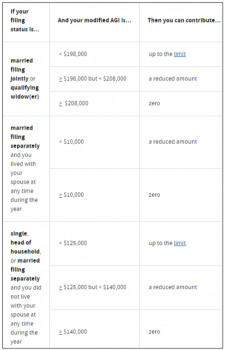Roth IRAs and Roth Conversions: Key Concepts
By: Diana Castro, CPA, CFP® Associate Advisor
Roth IRAs and Roth conversions tend to dominate headlines and talking points when it comes to retirement planning. Tax free growth! Tax free distributions! You only pay tax once! Therefore, this is one of the most frequently brought up planning strategies by potential and existing clients to discuss. Here at Goodman Financial, with our tax efficient DNA, we want to ensure utilization of this resource is appropriate based on the goals and situation of each client.
So, what exactly is a Roth IRA?
The Roth IRA, named after former Delaware Senator William Roth and chief legislative sponsor, was established by the Taxpayer Relief Act of 1997. Simply stated, a Roth IRA is a type of individual retirement account (IRA) in which a taxpayer funds with after-tax dollars and takes qualified tax-free withdrawals. For reference, a traditional IRA was established by the
Employee Retirement Income Security Act of 1974 (ERISA), and was available to taxpayers starting in 1975. A traditional IRA is generally funded with pretax dollars (i.e., contributions reduce your taxable income); however, you will pay tax on the withdrawals. In both types of IRA accounts, the earnings grow tax free.
General Rules for a Roth IRA
Whether a taxpayer is eligible to make a Roth IRA contribution is determined solely by your modified adjusted gross income (MAGI) level for your filing status. In addition, the annual contribution cannot exceed the taxpayer’s earned income. Qualified distributions (tax and penalty free) only occur when both of the following requirements are met. First, the distribution is made after a five-year holding period. Then, one of the following must be true:
- The owner attains age 59 1⁄2.
- The owner dies, and payment is made to a beneficiary or the estate.
- The owner becomes disabled.
- The distribution is being used to buy, build, or rebuild a first home.
There is no requirement to start taking distributions from a Roth IRA while the owner is still alive. This differs from a traditional IRA which is subject to required minimum distributions beginning when the owner turns 72.
Roth IRA conversions: Items to consider
Taxpayers can convert any amount in their traditional IRA to a Roth IRA. Any amount converted is treated as a taxable distribution subject to ordinary income tax for amounts that exceed basis. Conversions are not subject to the 10% premature withdrawal penalty, regardless of the owner’s age.
To determine if this strategy may be appropriate for you, consider the following questions.
- What is my current tax bracket and how might that change in the future? What income sources will change?
- Things to consider will be the timing of Social Security benefits, pensions, RMDs along with any earned income or even capital gains. Since RMDs are not required from Roth IRAs, this can help reduce future income by removing assets from your traditional IRA account.
- However, tax rates are unpredictable, and if your rate is lower in the future, you will have paid taxes at a higher rate at the time of conversion.
- How are my current assets allocated between different types of accounts and how will that differ with a Roth conversion?
- The types of accounts refer to taxable or nonqualified accounts, tax deferred or qualified money (such as an IRA or 401k), and tax-free money (Roth accounts). Having the flexibility in your portfolio to allocate assets between the three accounts along with determining tax efficient distributions is a benefit.
- However, a small proportion of tax-free money might not move the needle in a material way, which reduces any benefit.
- Are there estate planning goals this will help me achieve
- Depending on the beneficiaries, their tax bracket
may by lower than yours. - Again, this goes back to trying to predict tax rates
not only for yourself but potential beneficiaries.
- Depending on the beneficiaries, their tax bracket
- How will you pay the additional tax due?
- Ideally, you will have another source of funds to pay the tax bill instead of reducing the amount reinvested. Any amount not reinvested is lost opportunity.
- How quickly will you need to access the Roth IRA?
- As stated previously, to take advantage of the tax-free distributions you must wait five years. However, you can withdraw any amounts contributed any time without tax or penalty.
As you can see, a Roth conversion impacts various parts of your financial plan and each part might be
impacted differently. 
A few reminders:
- Ensure your beneficiary designations are current on your Roth IRA, along with your traditional IRA account(s).
- Take advantage of the annual contribution limit and catchup contribution amount for taxpayers age 50+. The limit applies to the combined contribution to an IRA and a Roth IRA. For 2021, the maximum contribution is $6,000 with a catchup contribution of $1,000 (total $7,000).
- Work with us and your CPA to calculate your earned income and MAGI for the tax year to determine eligibility. The table below is for 2021 contributions.
As you can see, Roth IRAs and conversions have nuances that we are happy to explore with you so that you can see beyond the headlines and understand the intricacies of the decision across your entire plan. And always, remember to consult your CPA.



